
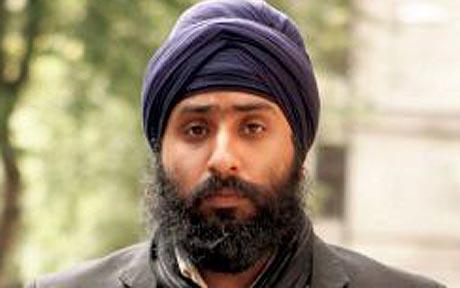 A couple of months ago the Sikh community was elated to see the Queen of England make two Sikh gentlemen her bodyguards. Thisact was seen as a huge step forward for Sikhs in the fight against discrimination for our religious articles of faith. It tremendously inspired many of us to continue the fight against Sikhs in the US Army and other places in the United States and Europe. It reflected what generations of hard Sikh work against discrimination for our religious articles of faith had done in the UK.
A couple of months ago the Sikh community was elated to see the Queen of England make two Sikh gentlemen her bodyguards. Thisact was seen as a huge step forward for Sikhs in the fight against discrimination for our religious articles of faith. It tremendously inspired many of us to continue the fight against Sikhs in the US Army and other places in the United States and Europe. It reflected what generations of hard Sikh work against discrimination for our religious articles of faith had done in the UK.
However, a recent case of a Sikh police officer in the UK feeling humiliated and offended for refusing to remove his turban as part of the Greater Manchester Police has shown us that as we take great steps forward we are still far away from taking a great leap against discrimination.
Gurmeal Singh, who is based in Wythenshawe Police station, near Manchester, said that he was coerced into walking into a petrol fire and told to wear a modified turban by colleagues. Despite telling police trainers that he had applied a flammable gel to his beard and refused to look like a character on a British comedy show, the officers told him- “this is what you signed up for”.
Singh said,
“My turban is not an article of clothing like a shirt or tie – it is part of me, a part of my religion and I feel as though my religion and I have become an issue for GMP.
“It has made me feel alienated. I was deeply offended and humiliated.”
The British Sikh Police Association are supporting Singh in his legal action. The hearing in his case continues.
 As all UK Sikhs or travelers to UK know at busy entries to the London Underground, you’ll find various vendors handing out free tabloids. Although everyone groans at the content, still enter the tube and you’ll find most busy Londoners flipping past the latest gossip on Paris Hilton or the recent election coverage in Afghanistan.
As all UK Sikhs or travelers to UK know at busy entries to the London Underground, you’ll find various vendors handing out free tabloids. Although everyone groans at the content, still enter the tube and you’ll find most busy Londoners flipping past the latest gossip on Paris Hilton or the recent election coverage in Afghanistan.
On Friday morning, many Londoners got a bright, colorful picture [click below the fold]. Although the content was nothing groundbreaking, still many of our Sikh readers (pagh salute: Joo Kay Singh) were pleased with the picture.
 The issue of marriage is complex and has as many circumstances as there are combinations of people in the world. Recently, a langa(r)eader wrote:
The issue of marriage is complex and has as many circumstances as there are combinations of people in the world. Recently, a langa(r)eader wrote:
Hi I as just wonderingif you are familiar at all with a sikh girl marrying a non sikh guy who is caucasian. Her parents banished her forever about 7 years ago and then finally contacted about 2 years ago but are still hung up on the fact. Just wondering what we can do to help them get over this faster. [received email]
Well I can’t make the parents ‘get over this faster’, but I can raise some observations and thoughts on marriage.
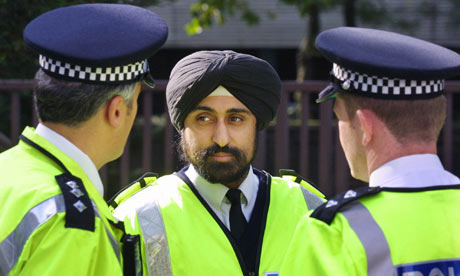 Sikh victims of crime will now be given the option of requesting a Sikh police officer to work on their case. Well, in London at least. The goal of this new service, offered by the Metropolitan Police, is to make use of the “special” knowledge officers have in regards to Punjabi culture to help address issues such as forced marriage and honor crimes. Many police officers believe that crimes have gone unreported and unsolved within the Punjabi Sikh community due to a lack of cultural understanding by police officers from a “white” background.
Sikh victims of crime will now be given the option of requesting a Sikh police officer to work on their case. Well, in London at least. The goal of this new service, offered by the Metropolitan Police, is to make use of the “special” knowledge officers have in regards to Punjabi culture to help address issues such as forced marriage and honor crimes. Many police officers believe that crimes have gone unreported and unsolved within the Punjabi Sikh community due to a lack of cultural understanding by police officers from a “white” background.
Palbinder Singh, chairman of the Metropolitan Police Sikh Association (MPSA) said: “It’s about understanding and appreciating difference. I don’t believe a white officer is ever going to be fully conversant with a Sikh for example. We have got evidence in the most serious type of crimes where Punjabi culture itself is the issue, that they haven’t been properly investigated.” [link]
Cringe.
When the British Sikh Police Association (BSPA) was set up, a spokesman suggested that the organization represented an important move towards social cohesion and integration, just like ‘other support networks within the police’. The BSPA did an excellent job at setting up an online service to allow women to report honor-based violence. It’s a completely valid effort to address the needs of minority communities – and something which should be celebrated. However, while I am a huge advocate for providing culturally and linguistically relevant services in all public sectors, I’m not sure that the solution proposed by the Metropolitan Police in England is necessary a good thing. Instead of providing diversity training to all members of the police force, this policy divides justice across ethnic lines.
 Turbanology, or knowledge of Turbans, is a TV documentary recently released in the UK which explores the meaning of the turban in England since the London bombings. Filmmaker, Jay Singh-Sohal, was working for a conservative think-tank in the US when he first began considering the misconceptions surrounding the turban and the subsequent profiling of individuals and communities. The documentary discusses the origin and importance of the turban in modern Britain to “see whether it’s just harmless headwear or really the fashion of a fantatic”.
Turbanology, or knowledge of Turbans, is a TV documentary recently released in the UK which explores the meaning of the turban in England since the London bombings. Filmmaker, Jay Singh-Sohal, was working for a conservative think-tank in the US when he first began considering the misconceptions surrounding the turban and the subsequent profiling of individuals and communities. The documentary discusses the origin and importance of the turban in modern Britain to “see whether it’s just harmless headwear or really the fashion of a fantatic”.
The film addresses the impact 9/11 and 7/7 has had on the [mis]understanding of the turban as a symbol of fear, hatred and global terrorism. Australian researchers at the University of New South Wales published a study in 2008 which found that simply noticing someone could be a Muslim increased the aggressive tendencies on the part of non-Muslim westerners. They called it the “Turban Effect.” Turbanology seeks to raise awareness of the turban’s importance and discuss why the people who wear it consider it a crown. In the documentary, Jay Singh-Sohal speaks to music producers, politicians and ordinary Sikhs and Muslims who have been affected by wearing a turban. (A preview of the documentary can be seen after the jump).
“The documentary discovers that simply noticing someone could be a Muslim increases the aggressive tendencies of westerners. The give-away sign is the turban, and the beard. Whether conscious or sub-conscious, the fact that terrorism is a worry for many people means that there’s been a rise in profiling who could be a threat – an issue explored in the piece.” [link]
 Two articles over the weekend got me thinking. I’ll get to them soon enough. Be patient!
Two articles over the weekend got me thinking. I’ll get to them soon enough. Be patient!
The issues aren’t new. I remember back to the late 1990s, when the community here in the Bay Area was moving to build the new San Jose Gurdwara. The Evergreen community protested and raised the typical objections – traffic, architecture that doesn’t ‘fit’ into the community, and sometimes the ‘undesirable neighbors’ argument.
Wherever Sikhs try to build something, these three arguments follow. The latest case…..Southall?
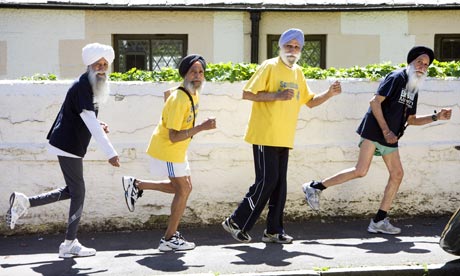
I am inspired. With the growing prevalence of cardiovascular disease, obesity and diabetes in our community – it is important to be inspired. Fauja Singh, Amrik Singh, Ajit Singh and Karnail Singh (with a combined age of 336) recently took part in the Edinburgh Marathon as part of the relay Sikhs in the City team. How have they stayed so healthy? The quartet agrees that a combination of a positive frame of mind, keeping the company of people who are forward looking, not indulging in any excesses, appreciating what God has provided them with and keeping active is the key to being healthy.
All four members of Sikhs in the City share an infectiously positive outlook and lust for life that is key to their ongoing success. Ajit Singh, 79, for instance, has just learned to ride a bicycle, so one of his goals now is to complete a triathlon. He and his lifelong friend Amrik Singh, also 79, have completed more than 1,000 races between them and acted as mentors to Fauja. Karnail Singh, 80, is the newest member of the team and the least experienced runner. His “experimentation” with course routes means that his teammates have to keep an eye on him, but what he lacks in kilometres he more than makes up for in providing the focus for a little gentle mickey-taking. [link]
This week I came across a couple of interesting stories out of the UK about how 1984 has since affected Sikhs. BBC Asian Network is currently previewing a radio documentary, hosted by Pops from Tigerstyle, discussing the impact Operation Bluestar has had on British Sikhs. The documentary discusses what impact, if any, 1984 has had on the Sikh conscience and the political activism that emerged. During that year, weekly covers of Des Pardes portrayed pictures of dead Sikhs – images that have stayed with many of us over the years. There existed a sense of hopelessness many Sikhs felt after only reading about and hearing of what was happening in Punjab. As one young Sikh woman states, “a record number of people took Amrit in that year”.
Before 1984 there were fears within the British Sikh community that young Sikhs, in particular, were assimilating into British way of life. A the time what Bluestar did was galvanize the community. .. and generally Sikhs were put on the spot by Operation Bluestar globally and in 1984, in the immediate aftermath, there was a great reassertion of Sikh identity – the visual representation of Sikh identity.
In a Guardian article yesterday, Sunny Hundal discusses how Operation Bluestar and the subsequent events have impacted Sikhs since.
Almost every year groups gather in London to commemorate these events and raise awareness of people still missing or locked up. Sometimes, the Indian flag is torched. In one report produced for the anniversary, the whole episode it is described as the “Sikhs’ Kristallnacht”. But while these facts are well documented and constantly discussed, there is less acknowledgement of how the episode has affected Sikhs since. [link]
He goes on to highlight three ways 1984 is still impacting Sikhs,
The recent caste-based violence in a Vienna and Punjab has shown us the horrible consequences of casteism. Sathnam Sanghera recently did a short report, “Caste Matters”, which investigates the possibility of legally outlawing caste-based discrimination in the UK.
Often we think caste-based discrimination is a 1st generation issue that becomes diluted in the Diaspora. However, CasteWatchUK has anecdotal evidence to show otherwise. They have lobbied to include caste-based discrimination as part of a stream-lined single equality act that would go into effect in 2010. If the group provided research evidence that caste-based discrimination existed in areas managed by the government, such as jobs and social services, then caste would be added to the equality act along with race, religion, and sexual orientation. However, this evidence has yet to be provided, aside from anecdotal examples from the work-place. The lack of aggregate evidence is only due to a lack of investigative research, as the anecdotal cases prove that it is indeed occurring.
You can listen the BBC Asian Network Report here.
Let’s us know what you think. Do you think caste-based discrimination should be included in equality acts in the Diaspora, such as the UK, USA, and Canada? If so, why?
This week, Peter Bance published “Sovereign, Squire and Rebel: Maharajah Duleep Singh and the Heirs of a Lost Kingdom.” It includes some little known and interesting information on Rani Jindan- the youngest of Maharaja 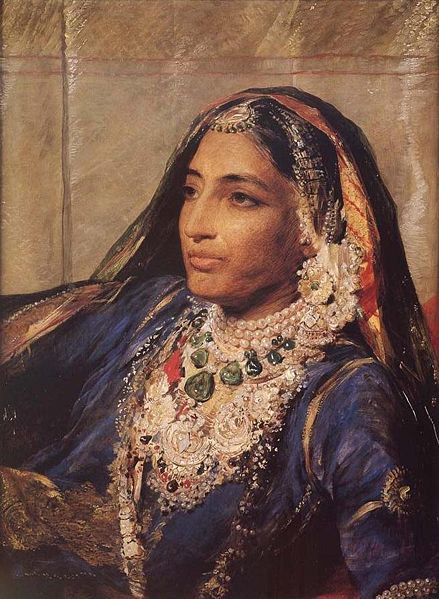 Ranjit Singh’s wives. While the tale of her son, Duleep Singh, has been well documented, less has been known about Rani Jindan.
Ranjit Singh’s wives. While the tale of her son, Duleep Singh, has been well documented, less has been known about Rani Jindan.
While researching a tome on the Duleep Singh family, which lived in exile on a sprawling country estate near Thetford, Norfolk, Mr Bance stumbled upon the gravestone of Jind Kaur in the catacombs of the Kensal Green Dissenters’ Chapel. Historians had assumed that the Maharani’s cremation occurred in India but here was a simple white marble tombstone in London with her name on it. [link]
So who was Rani Jind Kaur? Some things were previously known- that after the death of her husband, she became the Regent (acting head of state because the ruler is a minor) for her son, Duleep Singh.
To say that Jind Kaur was a thorn in the side of the East India Company would be an understatement. She was born into humble origins, the daughter of the Royal Kennel Keeper at the Sikh court in Lahore, but she was ravishingly beautiful and soon caught the attention of the Punjab’s greatest ruler, the one-eyed Ranjit Singh.
Having kept the British at bay for decades, Ranjit’s empire began to crumble with his death in 1839. Following a series of bloody succession battles, Jind emerged as regent for Duleep who was less than a year old when his father died. [link]
Rani Jindan was instrumental in organizing Sikh resistance to the British in the First and Second Anglo-Sikh wars.
Last year I commented on the UK government spending over £100,000 to (unsuccessfully) figure out how to create appropriate gear for Sikhs recruited into their anti-terror corps. It also wasted a lot of time for a Sikh officer who had been recruited to serve in the corps and then kept in limbo without assignment for over a year.
Well, someone somewhere got the memo. The still new BSPA is working with scientists to design and provide a Kevlar turban for its 2,000+ Sikh police officers, explaining that currently there is no other safe and religiously-appropriate option. The failure to provide this gear directly impacts the employment options and pathways of British Sikhs who serve as police:
Sikh officers have been prohibited from becoming firearms officers because our religion does not allow us to remove the turban…
There has been some research done into producing a ballistic material for turbans and we would like to follow any opportunity where we could manufacture a ballistic product – made out of something like Kevlar – that would ensure a certain degree of protection so Sikh police officers could take part in these roles.
If these turbans are actually useable and wearable, they could open professional options for Sikhs across a swathe of high risk “law and order” positions (and no doubt, the military). On the other hand, a Kevlar turban sounds terribly uncomfortable, and also seems like a somewhat strange alteration of the turban itself. Maybe I am having a hard time wrapping my head around the concept, but I’m not entirely sure how a Kevlar turban could be designed to be both religiously appropriate and, well, a solid hunk of material.

Vaisakhi in the diaspora usually brings two things to those living in cities with large Sikh communities: Nagar Kirtans and Vaisakhi concerts. Unfortunately, if you were an Amritdhari Sikh in London this year and you wanted to partake in both, you would have been out of luck. Tickets for the recent Gurdas Maan concert held at Wembley Arena had a unique warning printed on them, “NO KIRPANS OR SHARP OBJECTS”.
I won’t dwell too much on the irony of banning kirpans at a Vaisakhi concert, which usually start with the requisite dharmak songs, like Gurdas Maan’s tribute to Guru Gobind Singh and his contributions to Sikhi.
What I wonder is exactly what the organizers must have been thinking in doing this. I suspect the banning of kirpans probably falls under generic security rules banning knives and other weapons. In fact the terms and conditions on their website state that the “possession of any article, which is or may be used as a weapon or missile” is strictly prohibited. Pretty standard fare at all large venues.
According to the Sikh Times, Sikh police officers are coming together to help address discrimination within the workforce in addition to addressing community relations between Sikhs and the British police.
The Association, which is to launch next Wednesday, lists its goals as follows:
The aims and objectives of the BPSA are;
- To establish a national forum for Sikh members of the British police services
- To assist the British police services in developing strategies to recruit, retain, and progress Sikh members of the service hence increasing Sikh representation in the police service at all levels
- To provide a religious, cultural and social forum for members of the BSPA through celebration of dates and festivals on the Sikh calendar.
- To promote an understanding of the Sikh Faith and the Sikh values of democracy, equality and justice within the police services
- To provide support and advice to Sikh members of the police service.
- To promote social cohesion and integration.
A few months ago, with our first TLH book club, Jodha blogged about Sikhs In Britain. The book was a fascinating insight into how the lives of Sikhs living in England have been shaped over generations. In a similar attempt to historically document the Punjabi Sikh community in the UK, The Southall Story is a project that celebrates a town that has “welcomed new communities throughout the last century, enabling them to excel and influence both the social and political structures of this country.” Through a series of public events, performances, exhibitions and forums, the project aims to educate and inspire people about their heritage.
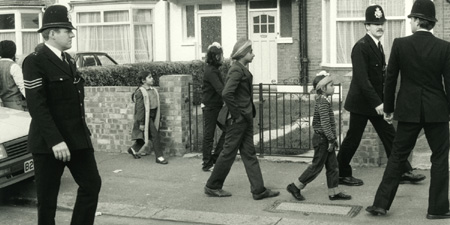
Southall is also a place that has come to be affectionately known as Little India, but for many it is much more than that. Being a port, (Heathrow is a stones throw away), Southall has been a home to such diverse groups as the West Indians, Indians and Pakistanis in the 50’s through to the Ugandan Asians in the 70’s. Most recently, new arrivals include Sikhs from Afghanistan and Somalians.
These settlements invariably have influenced and shaped Southall. Pivotal moments such as the racist murder of teenager Gurdip Singh Chaggar in 1976… meant that as a community issues of race and gender could no longer be avoided. [link]
An airline with potentially the best airplane food (for those with Punjabi palates) has just launched. Akal Air has just started bi-weekly flights (Wednesdays and Saturdays) from Birmingham, UK to Amritsar, a gateway for Sikhs to  Punjab.
Punjab.
Daljit Singh Birring, managing director of Akal Air, suggested that Birmingham International Airport is the “perfect base” for the airline. He said: “Access to Amritsar is of huge importance to the large Punjabi and Sikh population of the Midlands taking the pilgrimage to the Golden Temple and visiting family and friends.” [cheapflights uk]
The new flights are good news for the large Asian community in the Midlands. “Birmingham is the perfect base for Akal Air. Access to Amritsar is of huge importance to the large Punjabi and Sikh population of the Midlands taking the pilgrimage to the Golden Temple and visiting family and friends, as well as for business people trading with India’s emerging and developing economy,” says Akal Air managing director, Daljit Singh Birring. [link]
It seems that hospitality will be a major feature of the airline.
Akal Air customers will always be treated with respect, due care and consideration and be offered a pleasant flight experience by all Akal Air staff from Check-in, boarding, in-flight through to baggage claim. [Akal Air]
Happy travels to all in Birmingham! I hope to see Akal Air expand in the near future.
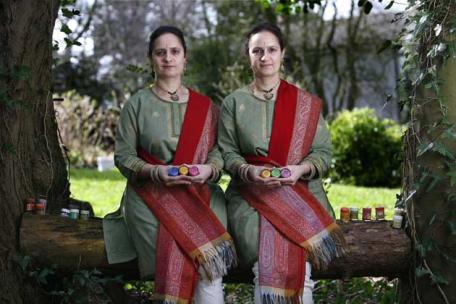 Does the West’s emphasis of the individual subvert community consciousness in the art world? UK-based artists Amrit and Rabindra Singh explain that the primacy of the individual versus other relationships does not resonate with art elites as naturally as it may for others:
Does the West’s emphasis of the individual subvert community consciousness in the art world? UK-based artists Amrit and Rabindra Singh explain that the primacy of the individual versus other relationships does not resonate with art elites as naturally as it may for others:
“Western contemporary art is all about the individual, the inner self,” reflects Amrit… We were constantly being told that to be individual was healthy, that we had to be more different from each other, be influenced by different Western artists from each other, but that didn’t seem valid to us. From the point of view of Sikh, Indian or even Asian philosophy, the community comes first and the individual is second.” [emphasis added]
I thought this article was a fascinating description and reflection on the structural challenges Sikh artists, particularly Sikh women of color artists, face within the art establishment in the U.K.
The twins described their sense of community and of shared experiences when conceptualizing and creating their art. This first barrier — that art that does not conform to the frame of mainstream art teaching — seems obvious, and yet such a subtle feature that it makes it difficult to push around it. This is a fairly distinct difference (individual vs. multiple social awarenesses) of philosophical development between the canon of European/American philosophers and philosophers from the different regions of Asia, but it was fascinating to see how it repeats and excludes through artistic representation. Not only that, it creates a less obvious form of discriminatory thinking in the art academy than the standard, run-of-the-mill racism.
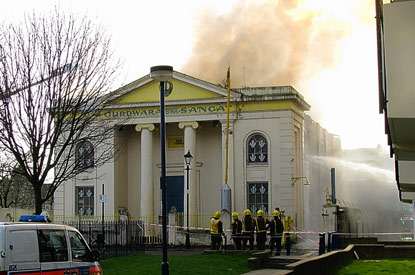 Recent news from East London is that Gurdwara Sikh Sangat has been substantially destroyed in an attempted arson attack. An official statement of the Executive Committee of the Gurdwara Sikh Sangat states that,
Recent news from East London is that Gurdwara Sikh Sangat has been substantially destroyed in an attempted arson attack. An official statement of the Executive Committee of the Gurdwara Sikh Sangat states that,
On Monday the 16th March 2009 at approximately 1.30pm, whilst some women were attending a Satsang a male person unknown to the worshipers entered the Temple through a side entrance. One of the worshipers came from the main hall and confronted the intruder coming down from the top floor and inquired why he was in the building. He replied that he had come to meet someone and then ran out.
Shortly after a fire was discovered coming from the top floor Sachkhand room (this room is where the Guru Grant Shaibs/holy books are kept) within the Temple complex. [link]
Most of the gurdwara’s roof has collapsed and the community fears that all but one of the Granth’s kept inside the gurdwara have been destroyed. The women who were in the gurdwara at the time were able to rescue one Granth from the flames, but unfortunately not the others.
“I can’t describe how important those holy books were to the Sikh community,” he added. Kulvinder Singh Virk, 26, who runs a local off-licence and is also a member of the temple, said: “This is very personal for us. It’s as if a member of our family has been burnt to death.” [link]
One worshipper said that in the past few weeks he had noticed racist graffiti on one of the gurdwara’s outer walls.
 Although it has been a few months since its ‘soft opening’, the National Sikh Heritage Centre and Holocaust Museum at Derby in the UK in July will soon host the Queen of England, Elizabeth II, to inaugurate the museum.
Although it has been a few months since its ‘soft opening’, the National Sikh Heritage Centre and Holocaust Museum at Derby in the UK in July will soon host the Queen of England, Elizabeth II, to inaugurate the museum.
Although many Gurdwaras have a ‘museum’-room and apparently on the internet we have a cybersikhmuseum, the initiative to bring scattered items of Sikh heritage is much needed and should be lauded.
The Museum hosts a number of artifacts, including a canon that belonged to the Sarkar-e Khalsa during the time of Sardar (often erroneously called Maharaja by Sikhs) Ranjit Singh.
The library is currently featuring an exhibit ‘From Jawans to Generals’ and in May will begin an exhibit on the Sikh Holocaust of 1984. They are beginning to collect rare books and hoping that the library will become a hub for Sikh scholarship.
The museum by bringing many such historical artifacts, located throughout UK together is more proof of the burgeoning of the Diaspora Sikh community and its finding new ways to engage with its changing self as well as non-Sikh community members. One hopes we will see similar initiatives in the US and Canada as well.
As I was randomly going through youtube clips a few days ago, I came across the above video of a group of Sikh children in Fremont, who learn kirtan in classical raags. Despite the poor audio, its obvious that they are good and I know this also from having heard them (and some of their contemporaries) in person – they are GOOD.
A couple of weeks ago Jodha reported on an article that brought to light the fact that Sikh children are practicing the tradition of kirtan, but what I think we didn’t discuss there is how this generation of Sikh musicians has really become one of classical musicians, learning stringed instruments of old and performing keertan in the Classical or raag framework. The growth has been obvious, especially in recent years – with the rise of institutions such as the The Raj Academy in Great Britain and the Gurmat Sangeet Department at Punjabi University Patiala, which specialize in providing instruction in traditional (classical) kirtan, and even the Miri Piri Academy in Amritsar of which the Chardi Kala Jatha (classically trained professional Sikh musicians who happen to be American in nationality) is a product.
Satnam Singh Gurwara, a 16-year-old refugee from Afghanistan, is currently being held in a detention center in Manchester, UK after his application for asylum was denied. His mother, is begging officials to show “humanity” and release her teenage son from the detention center. The Home Office is understood to have rejected his claim for asylum amid questions over his claimed age of 16.
Satnam Singh Gurwara says he was just 12 when he was snatched on his way to a Sikh temple in his native Afghanistan. He says he was held for two days and needed 39 stitches in his leg when he was released. But his family continued to face threats – and they decided to sell everything they owned and flee the country in April 2007. They settled in Bolton, where Satnam became a student at the community college. [link]
The Refugee and Asylum Participatory Action Research Organisation (RAPAR) is calling for the Home Office to release Satnam immediately.

